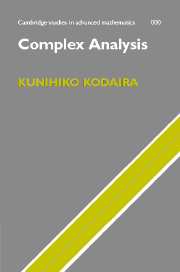5 - Riemann's Mapping Theorem
Published online by Cambridge University Press: 05 June 2012
Summary
Riemann's Mapping Theorem
We gave in Section 3.3c some examples of conformal mappings f: z → w = f(z) mapping a region D “of simple shape” in the z-plane into the unit disk in the w-plane. Given an arbitrary region D, in general it will be impossible to find a conformal mapping f which maps D onto the unit disk U by the composition of suitably chosen known functions. However, we have the following theorem concerning the existence of conformal mappings which map D onto U.
Riemann's Mapping Theorem. Let D be a region in the complex plane ℂ, z0 a point in D, and U = {w:|w| < 1} the unit disk in the w-plane. If D is simply connected and D ≠ ℂ, then there exists exactly one conformal mapping f:z → w = f(z) from D onto U that satisfies f(z0) = 0 and f′(z0) > 0.
Obviously for a conformal mapping f between D and U to exist, it is necessary that D be simply connected and D ≠ ℂ. Since, by Liouville's Theorem (Theorem 1.24), a function that is holomorphic and bounded on ℂ is a constant, there cannot exist a conformal mapping from ℂ onto U. If a conformal mapping f from D onto U exists, then f is a one-to-one continuous mapping from D onto U and its inverse mapping f−1 is continuous. Therefore, D has to be simply connected by the simple connectedness of U and the definition of simple connectedness (Definition 4.4). This section is devoted to proving Riemann's Theorem. We first give an outline of the proof.
- Type
- Chapter
- Information
- Complex Analysis , pp. 200 - 246Publisher: Cambridge University PressPrint publication year: 2007

